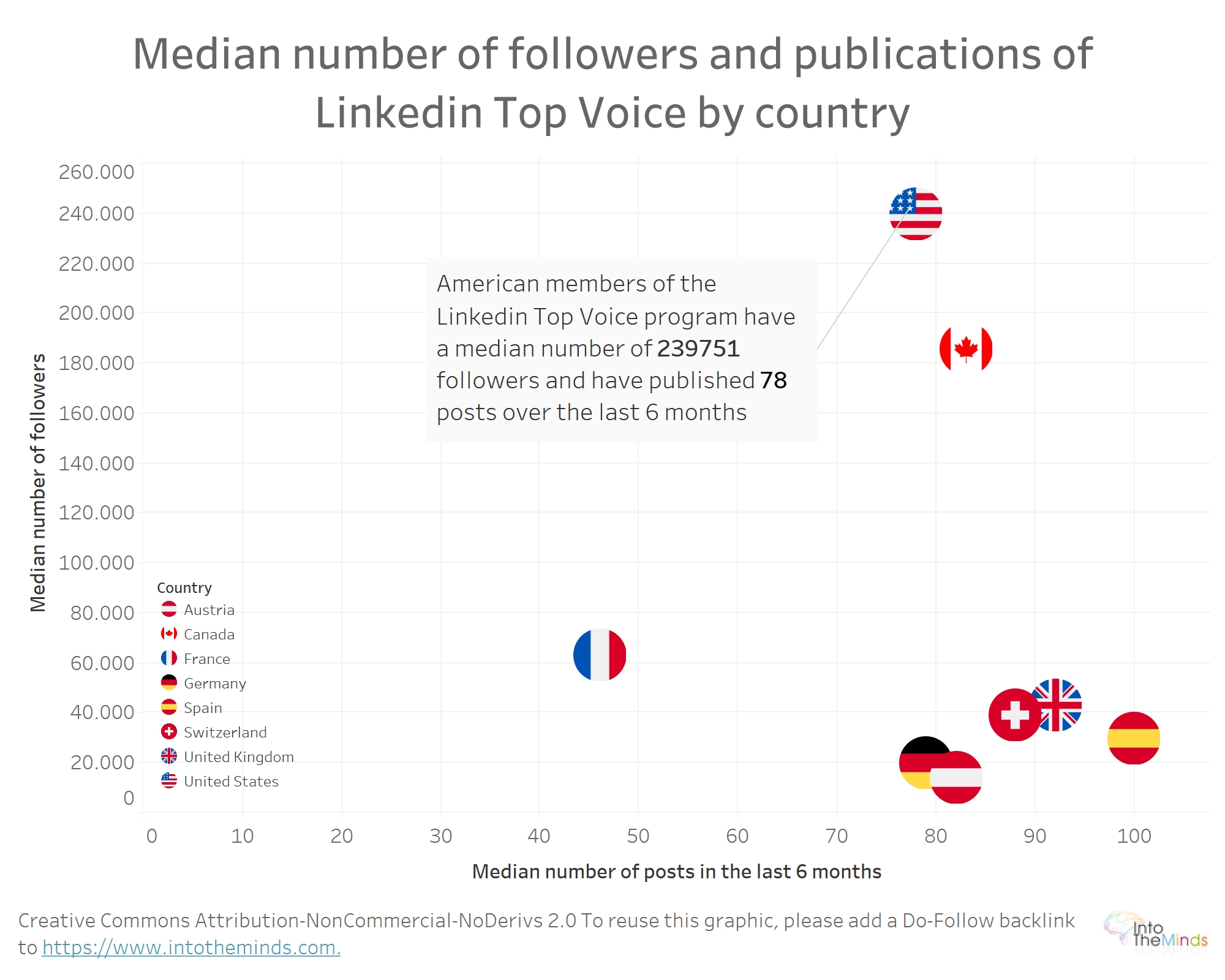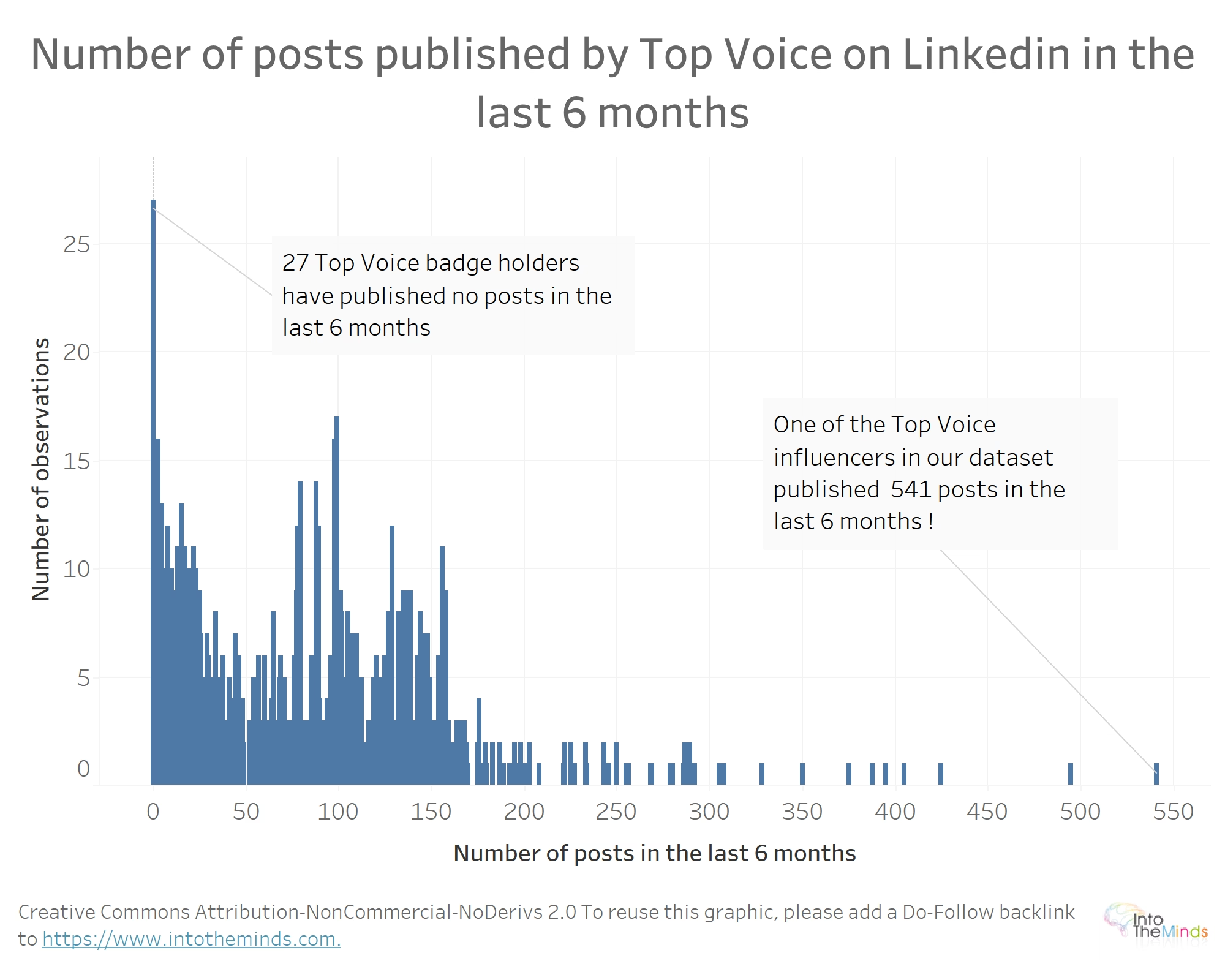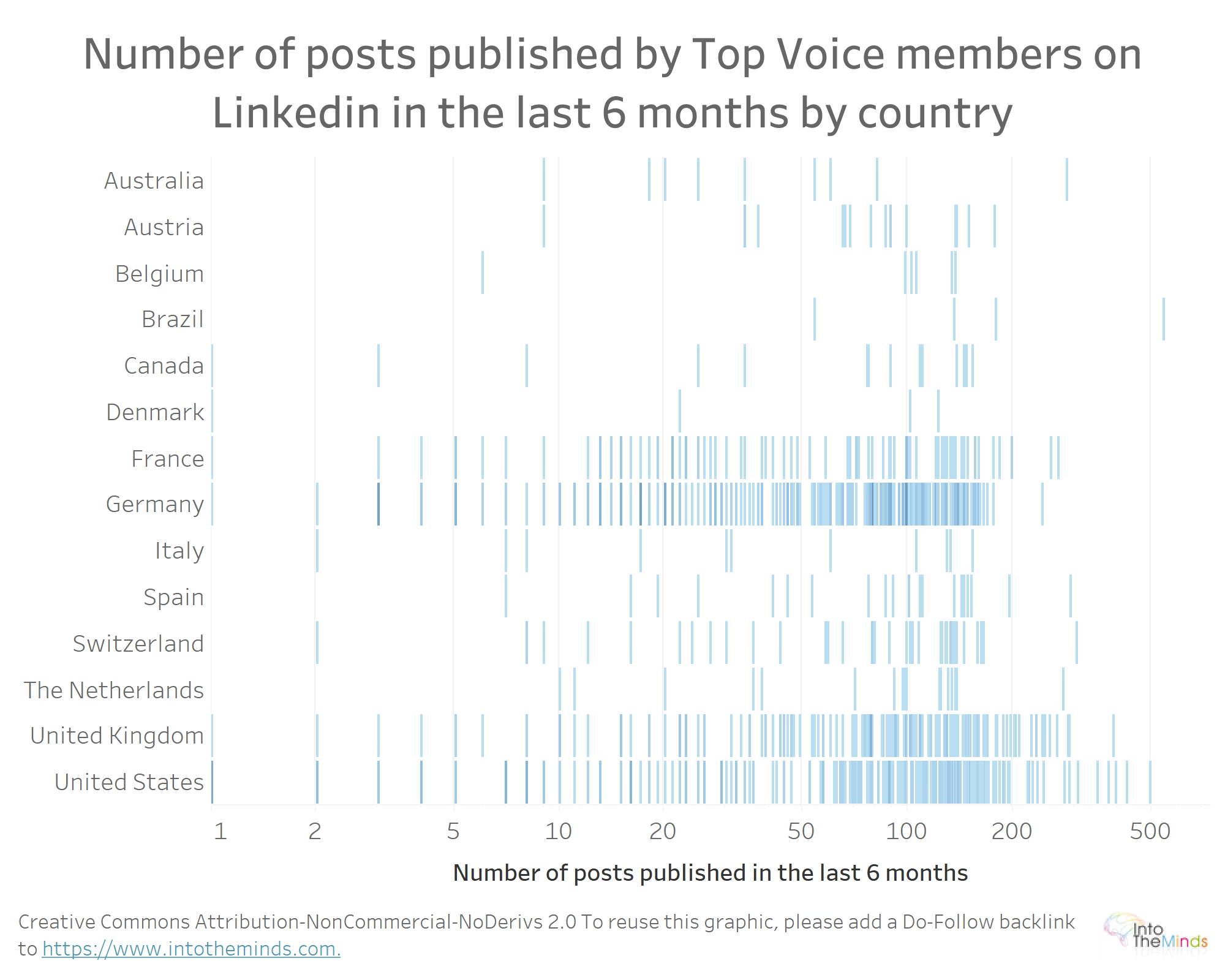This groundbreaking analysis reveals who the LinkedIn Top Voice program members are. We analyze 1,000 profiles worldwide to reveal the metrics determining entry into this closed circle.
![LinkedIn Top Voice: who are these influencers? [Research]](https://5cc2b83c.delivery.rocketcdn.me/app/uploads/algorithme-linkedin-2022.jpg)
Who are the people who wear the “LinkedIn Top Voice” badge on their LinkedIn profile? In this article, I reveal the results of exclusive research I have recently conducted on 1,000 Top Voice profiles. You will learn everything there is to know about these LinkedIn influencers, and you will see that, in some cases, it does not take much to enter this exclusive circle.Contact IntoTheMinds Market Research Agency
Key statistics on LinkedIn Top Voice profiles
- 44% of LinkedIn Top Voice are women
- 56% of LinkedIn Top Voice are men
- 94.8% of LinkedIn Top Voice women are between 30 and 50 years old
- 12.5% of men with LinkedIn Top Voice badges are over 50 years old
- -51%: on average, Top Voice women have 51% fewer followers than men
- -5.5: on average, Top Voice women have published 5.5 fewer posts than men over the last 6 months
- 47231: their median number of followers (men and women combined)
- 63241: the median number of male followers
- 31344: median number of followers for women
- 80: the median number of posts published in the last 6 months (men and women combined)
- In the UK, the median number of posts published in the last 6 months is 2 times higher than in France.
- In the USA, Top Voice has a median number of followers of 239751. It is only 19972 in Germany.
LinkedIn is a social network that fascinates me. I’m very active there myself (if you want to follow me or contact me, here’s my profile 😉 ). Over the past few years, I have conducted many complex research projects, the most famous of which was a study of a corpus of nearly 5 million posts and 1 million members. This enabled me to carry out predictive analysis of virality factors and to study the profile of authors of viral posts (mostly young women, I don’t know why). The huge dataset I had analyzed enabled me to publish previously unpublished statistics on LinkedIn.
The idea of virality remains central to my analysis, as influence is one of the great metrics of our time. Those who count have always been those who influence others. Now, social networks have enabled anyone to become an influencer. Understanding the mechanisms of influence, therefore, fascinates me.
What could be more natural than studying the members LinkedIn has chosen as having the most influence: the Top Voices.
How does one become a LinkedIn Top Voice?
The question on everyone’s lips is how to join the closed circle of LinkedIn Top Voices. The exact criteria are not known, but LinkedIn has given some clues in this post:
- create content regularly
- focus on the quality and originality of content
- demonstrate expertise
- respect the platform’s rules
How I researched 1,000 LinkedIn Top Voice profiles
To understand who the LinkedIn Top Voice influencers were, I needed data. However, this data does not exist in the public domain. LinkedIn does not disclose the precise criteria for awarding the Top Voice badge. I, therefore, had to build up a sufficiently representative sample of this population to understand its characteristics.
Between January 2025 and March 2025, I patiently collected information on 1,000 randomly selected LinkedIn Top Voice profiles. This random draw, therefore, makes it possible to create a representative sample. To avoid bias, however, I was careful to limit the number of American profiles to 25%. You will find most members of this closed circle in this country. But is it as closed as all that, since I could easily find 1,000 of them?
LinkedIn Top Voice profiles: the results in figures
Substantial differences between men and women
The first thing the analysis taught me was that there are substantial differences between men and women. Ever since my research on viral posts on LinkedIn, I’d had my finger on the pulse of this reality. But back then, it was more to the advantage of women.
For LinkedIn Top Voice, the situation is more to the advantage of men:
- they are more likely to benefit from this distinction: 56% versus 44% of women
- they have around 2 times more followers: their median is 63241 followers versus 31344 for women.
I can offer a more nuanced view of countries with a sufficiently large sample (France, Germany, the UK, and the USA). Influencers are still predominantly male (71.2% in France, 61% in the UK, and 63% in the USA). But in Germany, out of a sample of N=324, I was surprised that 58% were women.
As far as the number of followers is concerned, the situation is balanced in France and the USA:
- In France, Top Voice women have a median number of 62916 followers, compared with 63534 for men.
- In the USA, it is 236716 versus 239751.
In Germany and the UK, the gender imbalance is still very apparent.
It is easier to become a LinkedIn Top Voice in some countries
The analysis also shows that the requirements to become a LinkedIn Top Voice differ by country. In North America, the median number of followers is much higher:
- 185625 in Canada
- 239751 in the USA
By comparison, the bar is much lower in Europe. Here are the median numbers of LinkedIn Top Voice followers:
- Austria: 14155
- Germany: 19972
- United Kingdom: 43125
- Spain: 29886
- Switzerland: 39154
- France: 62916
Of course, no one knows whether the number of followers is an award criterion. LinkedIn awards the Top Voice distinction to members who generate the most engagement. Logically, however, someone who repeatedly generates engagement should attract more followers to their profile. That is why this metric is relevant.
Do I need to publish frequently to enter the Top Voice program?
If you are looking to become a Top Voice, you may be wondering whether the frequency of your posts is important. This is, of course, something I have studied. I have analyzed the posting frequency of the 1,000 influencers in my dataset.
What I have found is that, for all countries combined, over the last 6 months:
- The average is 85.28 posts
- The median is 80.50 posts
op Voice members post very frequently. Of course, there are exceptions, like the 27 people who did not post. But regularly publishing is a key success factor. If you think about it, it makes sense. Since the Top Voice badge rewards LinkedIn members who engage their community the most, regular posts can only achieve this. Unless you are a well-known personality (artist, star, politician, etc.), your reputation is independent of your engagement on LinkedIn.
I have analyzed posting behavior by country to delve deeper into the subject. As you can see from the graph below, there is a clear trend towards regular (and in some cases massive)
Subtle differences can be noted if I limit the analysis to countries with sufficient samples (France, Germany, UK, USA). English LinkedIn influencers publish much more content than their French counterparts. Their median number of posts over the last 6 months is 92, compared with 46 for the French.
So, we project ourselves on LinkedIn as who we are rather than what we know.
What do the LinkedIn Top Voice profile descriptions tell us?
Top Voice” influencers’ profile descriptions tell us a lot about how they want to project themselves on the social network. To make the profile descriptions visual, I created a visualization (below) based on the words contained in their profiles. I had, of course, taken care to eliminate linking words beforehand to keep only those that meant something.
Unsurprisingly, 22% highlight their new “LinkedIn Top Voice” badge in their profile description. You can see that these 3 words occupy the most semantic space.

Nuage de mots représentant les termes utilisés par les influenceurs Linkedin Top Voice dans leurs descriptions de profil. Copyrights : IntoTheMinds
Word cloud representing the terms used by LinkedIn Top Voice influencers in their profile descriptions. Copyrights: IntoTheMinds[/caption]
What fascinating is that, if we disregard the words “LinkedIn,” “Top,” and “Voice,” 8 of the 10 most frequently used terms describe the function of the individual in question: CEO, speaker, founder, … Only two terms describe a skill or area of expertise: “business” and “AI.” I also find it interesting that 3.5% of LinkedIn Top Voice users use the word “train” in their profile to indicate that they have worked for a particular company (ex-McKinsey, ex-L’Oréal, etc.) or university. It is as if certain stages in one’s life lend credibility to one’s entire career.
| Termes utilisés dans les profils Linkedin Top Voice | fréquence d'utilisation |
|---|---|
| ceo | 17,7% |
| speaker | 17,2% |
| founder | 14,3% |
| author | 13,0% |
| board | 10,6% |
| business | 9,4% |
| member | 9,0% |
| executive | 8,6% |
| AI | 7,2% |
| chief | 7,2% |
Moreover, if we extend the analysis to the first 50 terms used in profile descriptions, we find that 52% relate to function and 48% to expertise.
Conclusion
For the first time, this Research on LinkedIn’s Top Voice enables us to understand the metrics that make it possible to achieve this envied status. While the engagement rate is undoubtedly the most important criterion (and the choice of which is at LinkedIn’s discretion), the analyses show us that not all LinkedIn members are equal.
Notable differences exist between men and women on the one hand and, more surprisingly, between countries on the other. The bar seems lower to reach in Europe than in North America. This is undoubtedly due to the number of members in each geographic zone. Some countries are more “competitive” than others.
Finally, analysis of profile descriptions also reveals some interesting insights. The “Top Voice” badge is a source of pride for members who receive it. The words “LinkedIn,” “Top,” and “Voice” appear most frequently in profiles. But beyond that, the semantics employed show that this category of influencers identifies itself more by their function (CEO, entrepreneur, etc.) than by their expertise.












